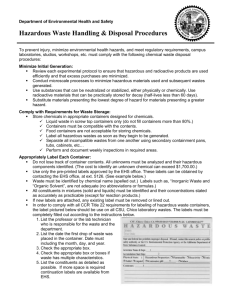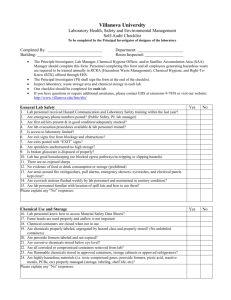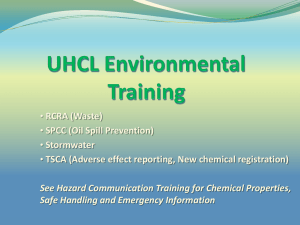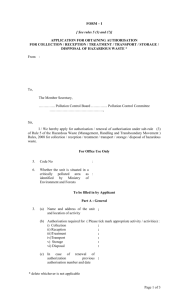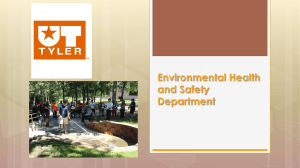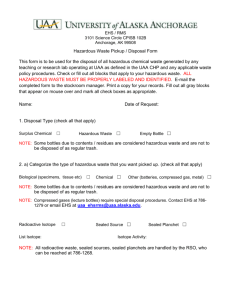What Is a Hazardous Waste? - SUNY College of Environmental
advertisement
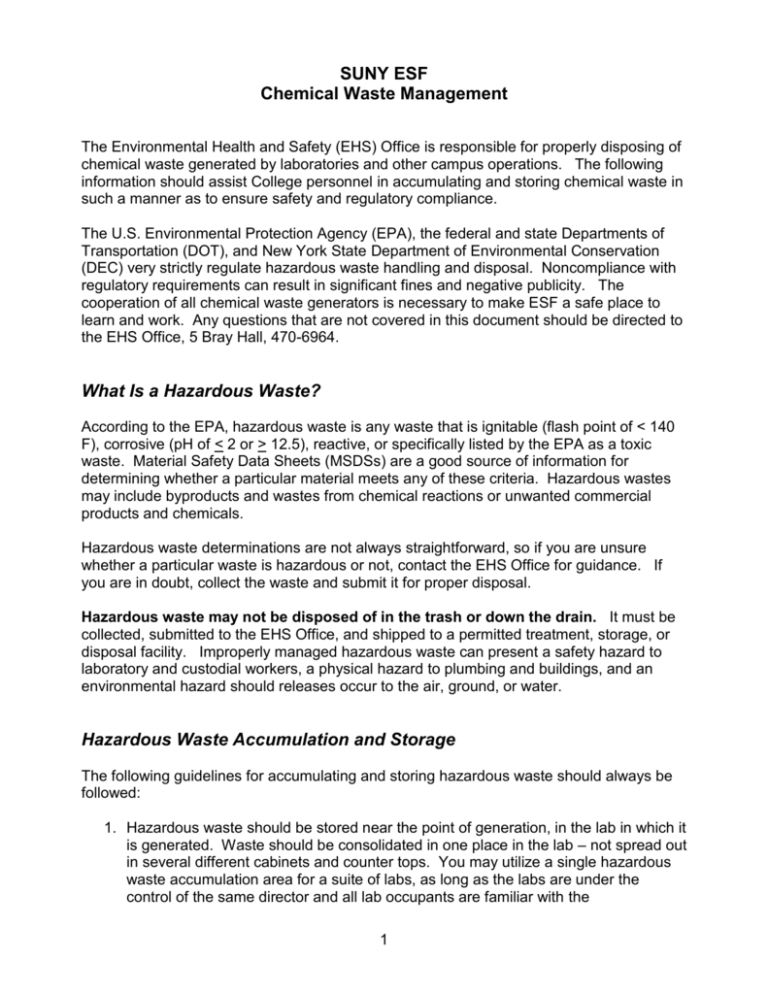
SUNY ESF Chemical Waste Management The Environmental Health and Safety (EHS) Office is responsible for properly disposing of chemical waste generated by laboratories and other campus operations. The following information should assist College personnel in accumulating and storing chemical waste in such a manner as to ensure safety and regulatory compliance. The U.S. Environmental Protection Agency (EPA), the federal and state Departments of Transportation (DOT), and New York State Department of Environmental Conservation (DEC) very strictly regulate hazardous waste handling and disposal. Noncompliance with regulatory requirements can result in significant fines and negative publicity. The cooperation of all chemical waste generators is necessary to make ESF a safe place to learn and work. Any questions that are not covered in this document should be directed to the EHS Office, 5 Bray Hall, 470-6964. What Is a Hazardous Waste? According to the EPA, hazardous waste is any waste that is ignitable (flash point of < 140 F), corrosive (pH of < 2 or > 12.5), reactive, or specifically listed by the EPA as a toxic waste. Material Safety Data Sheets (MSDSs) are a good source of information for determining whether a particular material meets any of these criteria. Hazardous wastes may include byproducts and wastes from chemical reactions or unwanted commercial products and chemicals. Hazardous waste determinations are not always straightforward, so if you are unsure whether a particular waste is hazardous or not, contact the EHS Office for guidance. If you are in doubt, collect the waste and submit it for proper disposal. Hazardous waste may not be disposed of in the trash or down the drain. It must be collected, submitted to the EHS Office, and shipped to a permitted treatment, storage, or disposal facility. Improperly managed hazardous waste can present a safety hazard to laboratory and custodial workers, a physical hazard to plumbing and buildings, and an environmental hazard should releases occur to the air, ground, or water. Hazardous Waste Accumulation and Storage The following guidelines for accumulating and storing hazardous waste should always be followed: 1. Hazardous waste should be stored near the point of generation, in the lab in which it is generated. Waste should be consolidated in one place in the lab – not spread out in several different cabinets and counter tops. You may utilize a single hazardous waste accumulation area for a suite of labs, as long as the labs are under the control of the same director and all lab occupants are familiar with the 1 activities/experiments of the others. Hazardous waste should not be moved down hallways or to other floors. 2. All waste must be collected in tightly closing, leak-proof containers that must be kept closed except when adding waste. Therefore, stoppered glassware or beakers are not appropriate waste collection containers. Waste collection containers may not be left open with funnels. 3. Ensure the waste material is compatible with the collection container and will not react with it, for example, do not put corrosives in metal containers. In general, plastic containers are preferred to glass, as they are less likely to break if knocked over. If a particular waste is generated on a fairly large scale, as with some solvents, you may want to obtain a 2 ½ gallon plastic container from the EHS Office for collection. Smaller containers are also usually available from either the EHS Office or the Chemical Stock Room. 4. Only similar wastes should be collected in the same container. Mixing incompatible or different types of wastes may cause a chemical reaction or greatly increase disposal costs. Therefore, you may have several different waste containers accumulating at the same time, for example, one for non-chlorinated flammable solvents, another for acids, etc. 5. Hazardous waste containers must be labeled with the words “Hazardous Waste” in addition to their specific chemical contents. Hazardous Waste labels are available through the EHS Office and the Chemical Stock Room. Be sure to also list on the label the specific contents; for example, flammable solvents – acetone, hexane. Chemical names must be completely spelled out, abbreviations or chemical structures are not allowed. If you use an empty commercial chemical container to collect waste, you must obliterate the old chemical label to avoid possible confusion as to the contents. 6. Waste containers, as any chemical container, should not be stored in a location where a spill could potentially cause a release to the environment. Containers should not be stored next to sinks and ideally not in hoods with sinks. Containers should not be stored on the floor where they can be kicked over, particularly in rooms with floor drains. Laboratory Chemical Inventories and Housekeeping For safety reasons, it is best to keep the number of chemicals on-hand in the laboratory limited to those actually in use or planned for use. Periodic reviews of chemical inventories are encouraged to eliminate unwanted chemicals. This is also a good opportunity to ensure all containers are in good condition and clearly labeled. Over time, labels can fade or fall off, leaving an unidentified chemical. It is also a good policy to ensure students and researchers properly dispose of any wastes or residuals from their work prior to leaving ESF. Too often, unidentified chemical 2 containers are left for later lab occupants to deal with. If the contents cannot be identified, the cost of disposal greatly increases, and accidents can result from improper handling. Removal of Chemical Waste When you have waste containers that are full or that you are finished working with, contact the EHS Office to arrange for the material to be picked up. Completely fill in a Surplus Chemical/Waste Disposal Form, being sure to indicate the composition of the waste and quantity and size of containers. When listing waste components, also include approximate percentages; for example, methylene chloride 50%, water 50%. Send the top white copy of the form to the EHS Office - 5 Bray Hall and attach the bottom copy to the waste container. Alternately, if you have a large number of different wastes, you may submit a list that includes all the pertinent information from the Surplus Chemical/Waste Disposal Form. Make sure all containers are in good condition for transport and clearly labeled. Wipe off any spilled material and close the top tightly. Assuming there are no questions regarding the waste, someone from the EHS Office will then remove the waste from your lab. If you have unused chemicals that you wish to dispose, make an effort to find someone who may be able to use them, prior to submitting them for disposal. This can save another lab the cost of purchasing the chemical, as well as saving the college the cost of its disposal. However, if the chemical is no longer usable, or you are unable to find a new user, submit it to the EHS Office for proper disposal. Other Types of Waste Laboratories are generally responsible for disposal of their own non-hazardous wastes, but the EHS Office is available to assist with determination of a proper disposal method. Additionally, the EHS Office will remove the following non-hazardous wastes from laboratories. These materials should not be labeled “Hazardous Waste”. Sharps – including hypodermic syringes and needles. These items are considered regulated medical waste and should be stored in a rigid plastic, leak-proof, puncture-resistant container, clearly marked “Sharps”. The container must also be marked with the word “Biohazard” or a universal warning sign label. Pump oil – This is not a hazardous waste, but it is regulated by New York State. Collect oil in an appropriate waste container, labeled “Used Pump Oil”. Be careful not to mix oil with hazardous wastes. Radioactive Waste Radioactive waste handling is strictly regulated by the Federal Nuclear Regulatory Commission and the New York State Department of Health. Contact the Radiation Safety Officer for proper collection and disposal procedures. 3
